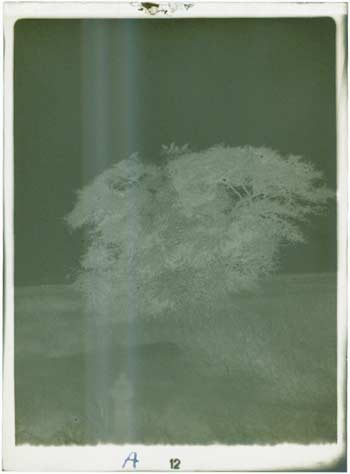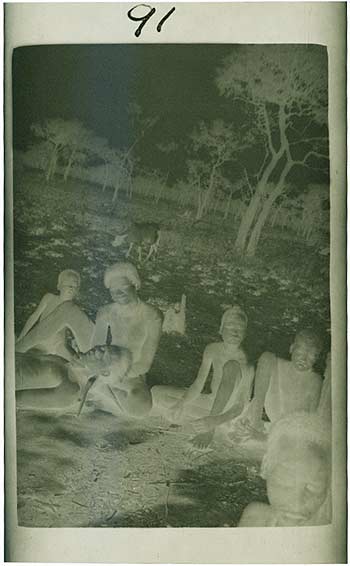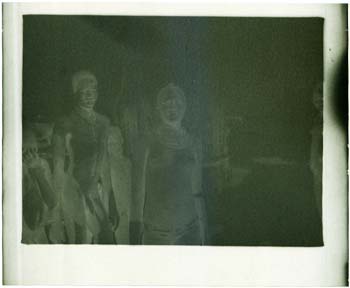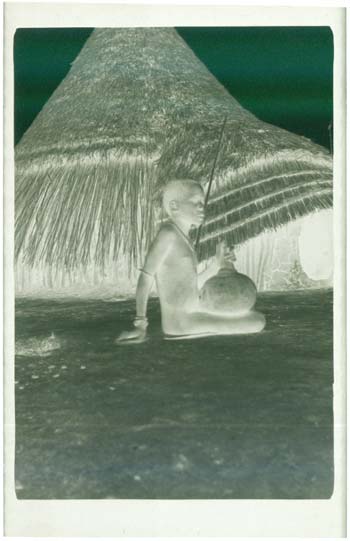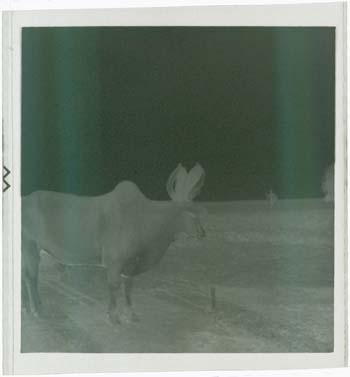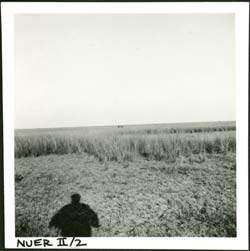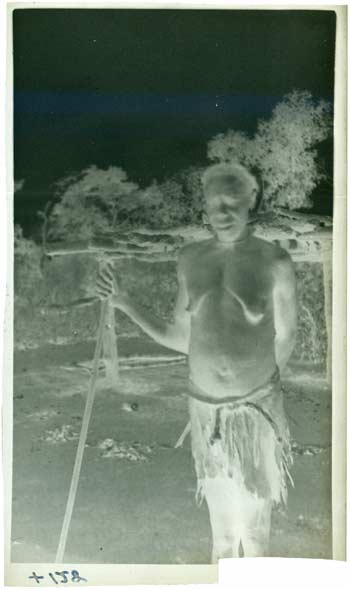Photographer
- John E. Allen
- Richard Buchta
- Jean Carlile Buxton
- E. E. Evans-Pritchard Collection:
- Godfrey Lienhardt
- Charles Kingsley Meek
- G. N. Morhig postcard series:
- Percy Horace Gordon Powell-Cotton
- Charles Gabriel Seligman slide collection
- Wilfred Patrick Thesiger
Edward Evan Evans-Pritchard (1902-1973)
View photographs by Edward Evan Evans-Pritchard.
The 2500 photographs taken by Evans-Pritchard during his anthropological fieldwork between 1926 and 1936 are at the core of the Pitt Rivers Museum’s photograph collections relating to Southern Sudan. His connection with the Museum was long established by the time he deposited his field archive in 1966 - he donated his first object in November 1929, and the Museum was both a recipient of gifts and a purchaser of artefacts from Evans-Pritchard in the years that followed. Before then as a History undergraduate at Exeter College, where the anthropologist R. R. Marrett was a Fellow, Evans-Pritchard had gained an interest in the study of non-Western peoples, reading works by Tylor and Frazer. Wishing to pursue this interest through fieldwork he then studied under C. G. Seligman and Bronislaw Malinowski at the London School of Economics. Following Seligman’s contacts within the colonial administration of the Anglo-Egyptian Sudan, Evans-Pritchard embarked on intensive fieldwork among the Azande in late 1926, first paying a visit to the Ingessana and other groups of Dar Fung, almost certainly at the behest of Seligman. During this first Zande trip he also carried out ethnographic surveys of a number of groups in Bahr-el-Ghazal province, again for inclusion in Seligman’s survey work that appeared in 1932, Pagan Tribes of the Nilotic Sudan (London: Routledge). He began government-sponsored fieldwork among the Nuer (and completed work among the Azande) in 1930, which was followed by another stint in 1931, and two shorter trips in 1935 and 1936. He also carried out fieldwork along the Akobo River among Anuak communities in 1935, and some 400 photographs relate to this trip.
Evans-Pritchard published numerous articles as a result of this series of intensive fieldwork expeditions in Southern Sudan, many of which were collated in his well-known books Witchcraft, Oracles and Magic Among the Azande (Oxford University Press, 1937), The Nuer (Oxford University Press, 1940), Kinship and Marriage among the Nuer (Clarendon Press, 1951), Nuer Religion (Oxford University Press, 1956), and posthumously Man and Woman among the Azande (Oxford University Press, 1974). Many of his photographs appear within these and other publications.
Between 1930 and 1940 Evans-Pritchard was employed in a variety of positions, including part-time lectureships in London and Oxford, as well as three years (1932-1934) as Professor of Sociology at King Fuad I University in Cairo. He was commissioned in the Sudan Defence Force in 1940 and fought with Anuak troops along the Sudan-Ethiopia border. At the end of the war he was appointed Reader in social anthropology at Cambridge, but soon moved to the professorship at Oxford in 1946 to succeed A. R. Radcliffe-Brown, where he remained until his retirement in 1970. Knighted in 1971 in recognition of his career and achievements, he died in 1973.
Photography – Negative formats
3 1/4 x 4 1/4 inch – ‘quarter plate’
This is the main format for photographs taken by Evans-Pritchard between 1926 and 1930, and is therefore present throughout much of the Azande, Moro, Ingessana and Bongo series. It is also a significant format in the first Nuer series between 1930-1931.
This size film (designated 118 size) was used by a number of cameras. Kodak, for example, introduced the No.3 Autograph camera from 1914-1926. This produced 3 1/4 by 4 1/4 inch negatives, usually six exposures to a spool, yet the 1928 Kodak dealer catalogue noted that 118 film would also 'be supplied in 12 exposure spools, on request, for the use of Travelers, Explorers etc'.
The mechanically printed numbers on the bottom of many of the negatives is evidence that they actually come from a film pack. These were packs of sheet film that could be used with an adaptor in place of dark slides holding glass plates. Film packs were popular because they were lighter and more convenient than glass plates and, of course, were not prone to breakages. With a suitable adaptor, film packs could be used with any standard plate camera. They were available in a range of formats, including quarter-plate and there were normally twelve sheets of film in each pack, which accords with the numbers found on the Evans-Pritchard negatives (see image).
1 5/8 x 2 1/2 inch
This format is probably that known as size 121 for a folding pocket Kodak No.O, which was introduced in 1902. It is a frequent format in the Azande series, as well as the first Nuer series, but he does not seem to have used it after about 1931. This may be the “little Kodak” that he mentions using in 1927 to Hugo Bernatzik.
1 1/4 x 1 1/2 inch (40 x 30 mm)
This format is probably that known as 127 film, produced from 1912-1995 by Kodak for the compact Vest Pocket Kodak camera. 127 film came in three slightly different sizes, but it seems that the 40 x 30 mm rectangular format used by Evans-Pritchard came in rolls of 16 exposures. It is a frequent format in Evans-Pritchard’s first Nuer series but not elsewhere, indicating that he used it in 1931. The lightness and discreteness of this camera format would have been extremely suited to the troubled social and political conditions of this phase of his Nuer fieldwork, as well as the need to trek long distances on foot.
2 1/4 x 3 1/4 inch – Portrait format
This portrait format was produced on 120-size film (2 1/4 inch width), first introduced in 1897 for the No.1 Kodak Folding Pocket Camera, producing 8 exposures per film. It is a frequent format in Evans-Pritchard’s second Nuer (Album) series, indicating that he used a Folding Pocket camera on his 1935 and 1936 fieldtrips. Kodak did make a 620 camera that used the same size film from 1932.
2 1/4 x 2 1/4 inch (6 x 6 cm) – Square format for Rolleiflex camera
This square format, also on 120-size film, was produced using a Rolleiflex camera, most likely the Standard model (introduced in 1932) allowing about 12 exposures per film. Evidence for this can be found in Evans-Pritchard's shadow in a number of images, which show him looking down into the ground-glass focusing plate on the top, rather than holding it up to the eye.
This format is the most common in the second Nuer series, which relates to the 1935 and 1936 fieldwork trips. It is also the format of the Anuak series (1935), and also for his Kenyan Luo series (1936). Since it is also a significant format (along with the 2 1/4 x 3 1/4 inch) in his 1934-35 Nile region photographs, it can be suggested that Evans-Pritchard began using a Rolleiflex some time shortly after he took up his post as professor of sociology at King Fuad I University in Cairo in 1932.
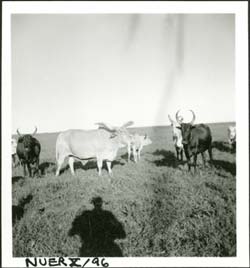 Reverse of 1998.355.496.2
Reverse of 1998.355.496.2
3 1/4 x 5 1/2 inch – postcard
This postcard-sized format is found in around 90 Zande series negatives, used by Evans-Pritchard sometime between 1926-1930. This size film was designated 122 and could be used with the 3A Kodak Folding Pocket Camera, produced between 1903 and 1915. Used in 4, 6 or 10 exposure lengths, it was not straightforward to focus – when using roll film the range had to be estimated. This may account for the poor focus Evans-Pritchard usually achieved when using this format.


